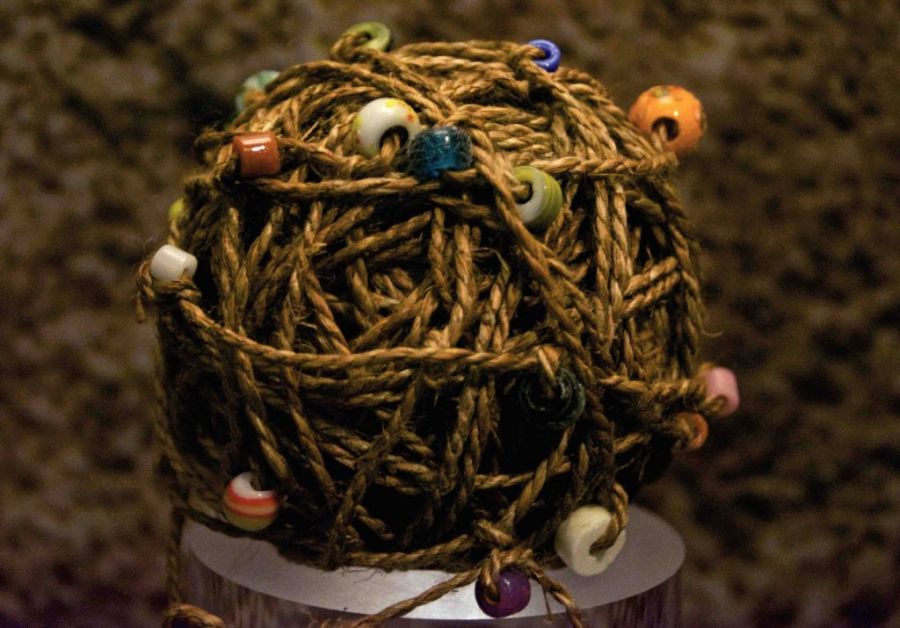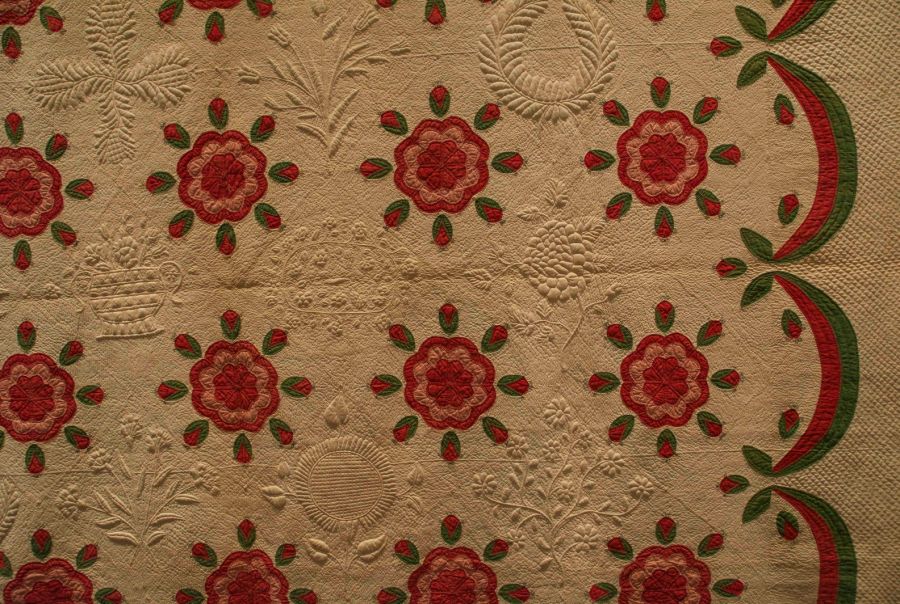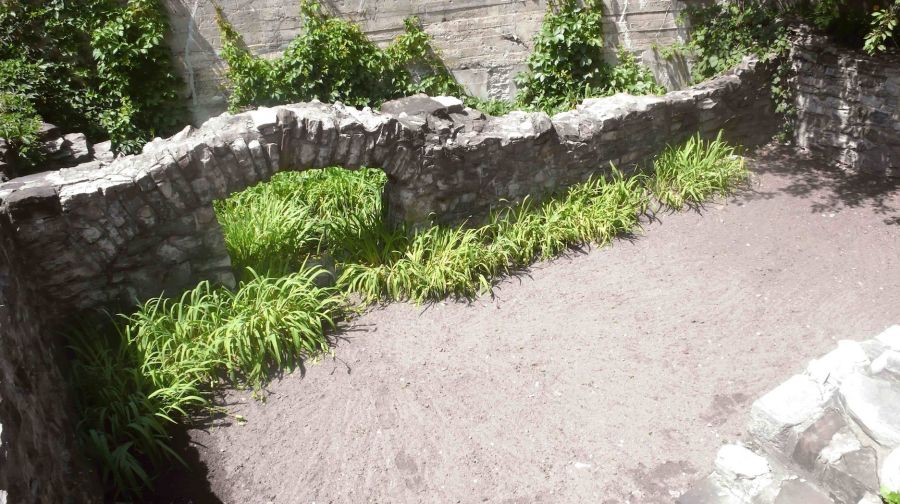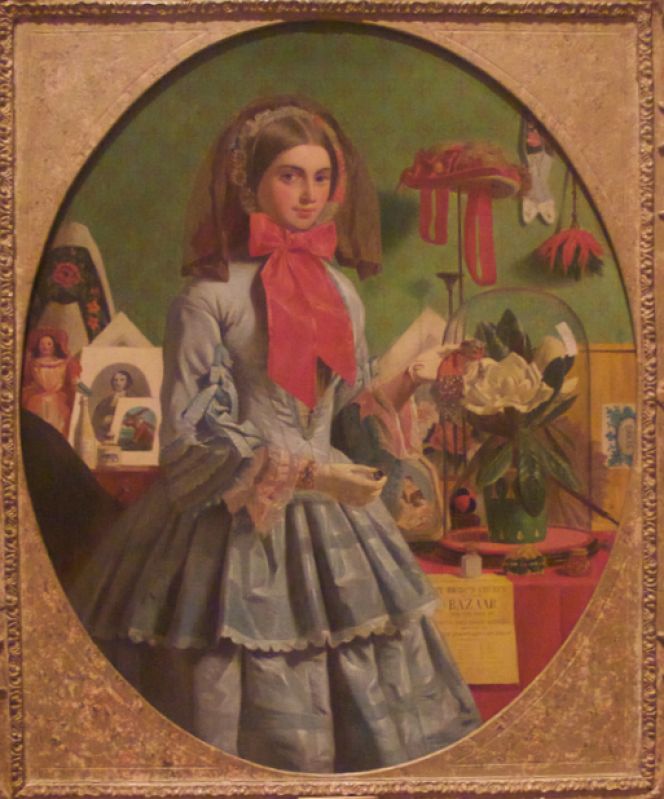ikfoundation.org
The IK Foundation
Promoting Natural & Cultural History
Since 1988


 Crowdfunding Campaign
Crowdfunding Campaignkeep knowledge open, connected, and growing on this textile history resource...
UNEXPECTED TEXTILES AND TRADITIONS
– in North America
During this year, I have had the opportunity to take part in a journey covering the province of Quebec in Canada and the U.S. states of Pennsylvania, New York, and Massachusetts and finally, a stay in Washington D.C within The IK Foundation’s fieldwork “The Bridge Builder Expedition – North America“. Textile studies were also possible, planned as well as spontaneous! This introduction will display and describe some examples from the fascination of finding unexpected textile gems and traditions, while more detailed texts will follow dealing with studies of rare publications, textile materials, natural dyes, special collections etc. The aim of this new series of essays is to give a number of historical observations from N.E. USA and S.E. Canada – spanning from the 16th- to the 19th century.
 Oral traditions are usually transmitted from one generation to another through speech or song, but a “time ball” could be another way of re-telling passed events. This native American tradition is traced to the Yakama people, and keeping such a ball was a young woman’s way to remember important occasions in her lifetime, such as courtship, marriage, birth of children etc. with knots and beads placed in a type of timeline. The yarn was made of native growing hemp and twined to a “time ball”, in this way a woman’s whole lifetime could be recorded with the help of one or several balls. These balls could also be untwined when the elderly woman wanted to remember the past or tell the family’s history for younger generations. It was tradition to bury the ball/balls with the woman when she passed away. (Hemp time ball, replica made by Vivian “Stu yat” Harrison 2003, Washington National Museum of the American Indian). Photo: The IK Foundation, London.
Oral traditions are usually transmitted from one generation to another through speech or song, but a “time ball” could be another way of re-telling passed events. This native American tradition is traced to the Yakama people, and keeping such a ball was a young woman’s way to remember important occasions in her lifetime, such as courtship, marriage, birth of children etc. with knots and beads placed in a type of timeline. The yarn was made of native growing hemp and twined to a “time ball”, in this way a woman’s whole lifetime could be recorded with the help of one or several balls. These balls could also be untwined when the elderly woman wanted to remember the past or tell the family’s history for younger generations. It was tradition to bury the ball/balls with the woman when she passed away. (Hemp time ball, replica made by Vivian “Stu yat” Harrison 2003, Washington National Museum of the American Indian). Photo: The IK Foundation, London. At the time for a visit at the American Folk Art Museum, a number of exquisitely made quilts were on display. This close-up shows a particularly beautiful example from Kentucky dating c. 1850 – a so-called “Whig Rose and Swag Border Quilt” of cotton, made by unidentified slaves, for Mrs. Marmaduke Beckwith Morton (1811-1880). If it had not been for a handwritten label pinned at the back noting that female slaves of the household had stitched the quilt, it had been assumed that the lady of the house had been the hand behind this exquisite workmanship. The exhibition also emphasised: ‘Until fairly recently, such finely stitched quilts made in the South were typically attributed as the work of the mistress of the household. In truth many were made by female slaves with specialised sewing skills who worked in the home rather than the fields’. (American Folk Art Museum, New York, no 2012.8.1). Photo: The IK Foundation, London.
At the time for a visit at the American Folk Art Museum, a number of exquisitely made quilts were on display. This close-up shows a particularly beautiful example from Kentucky dating c. 1850 – a so-called “Whig Rose and Swag Border Quilt” of cotton, made by unidentified slaves, for Mrs. Marmaduke Beckwith Morton (1811-1880). If it had not been for a handwritten label pinned at the back noting that female slaves of the household had stitched the quilt, it had been assumed that the lady of the house had been the hand behind this exquisite workmanship. The exhibition also emphasised: ‘Until fairly recently, such finely stitched quilts made in the South were typically attributed as the work of the mistress of the household. In truth many were made by female slaves with specialised sewing skills who worked in the home rather than the fields’. (American Folk Art Museum, New York, no 2012.8.1). Photo: The IK Foundation, London.![This second chosen quilt from the American Folk Art Museum, dating c. 1790s to 1810s also has an interesting story to tell. As with many folk art objects its origin/artist is unknown or uncertain, while the center block illustrated here on the other hand was printed by John Hewson (1744-1821). He was a British calico printer moving to America in 1774 – with the help of a letter of recommendation from Benjamin Franklin – establishing his business in an area outside Philadelphia where he advertised for “printing calicoes and linens for gowns, &c., coverlids, handkerchiefs…” Hewson was a skilled worker and just such an artisan tradesman that was seen as important for the needs of the people in the American colonies. There are other examples as well in American collections of bedcovers including Hewson’s block printed vase overflowing with flower motifs, such as in the extensive collection of Philadelphia Museum of Art [Blum, Dilys E., The Fine Art of Textiles…p.93] (American Folk Art Museum, New York, no 2006.5.1). Photo: The IK Foundation, London.](https://www.ikfoundation.org/uploads/image/3-unexpected-900x601.jpg) This second chosen quilt from the American Folk Art Museum, dating c. 1790s to 1810s also has an interesting story to tell. As with many folk art objects its origin/artist is unknown or uncertain, while the center block illustrated here on the other hand was printed by John Hewson (1744-1821). He was a British calico printer moving to America in 1774 – with the help of a letter of recommendation from Benjamin Franklin – establishing his business in an area outside Philadelphia where he advertised for “printing calicoes and linens for gowns, &c., coverlids, handkerchiefs…” Hewson was a skilled worker and just such an artisan tradesman that was seen as important for the needs of the people in the American colonies. There are other examples as well in American collections of bedcovers including Hewson’s block printed vase overflowing with flower motifs, such as in the extensive collection of Philadelphia Museum of Art [Blum, Dilys E., The Fine Art of Textiles…p.93] (American Folk Art Museum, New York, no 2006.5.1). Photo: The IK Foundation, London.
This second chosen quilt from the American Folk Art Museum, dating c. 1790s to 1810s also has an interesting story to tell. As with many folk art objects its origin/artist is unknown or uncertain, while the center block illustrated here on the other hand was printed by John Hewson (1744-1821). He was a British calico printer moving to America in 1774 – with the help of a letter of recommendation from Benjamin Franklin – establishing his business in an area outside Philadelphia where he advertised for “printing calicoes and linens for gowns, &c., coverlids, handkerchiefs…” Hewson was a skilled worker and just such an artisan tradesman that was seen as important for the needs of the people in the American colonies. There are other examples as well in American collections of bedcovers including Hewson’s block printed vase overflowing with flower motifs, such as in the extensive collection of Philadelphia Museum of Art [Blum, Dilys E., The Fine Art of Textiles…p.93] (American Folk Art Museum, New York, no 2006.5.1). Photo: The IK Foundation, London. In rue Notre Dame in Lower Quebec City several stone houses from the 17th century have been preserved, together with these depicted historical ruins once housing tailors and wigmakers. From research and excavations it is known that the tailors Larose and Philippe Nepveu lived and worked here in 1667. Another textile tradesman on this street was Jacques Loyer de la Tour who had a business selling fabrics, ready-made clothes, coloured and striped ribbons, buttons, braided silver decorations and other haberdashery goods. An excavation has also unearthed a lead seal from Lyon, at the time a French textile centre from were it is believed the majority of the silk fabrics were exported to New France and among other places sold in this Quebec street. In the next century the establishments on this street were still involved in the trade of fashion, while six wigmakers had their businesses here between 1725 and 1760. Photo: The IK Foundation, London.
In rue Notre Dame in Lower Quebec City several stone houses from the 17th century have been preserved, together with these depicted historical ruins once housing tailors and wigmakers. From research and excavations it is known that the tailors Larose and Philippe Nepveu lived and worked here in 1667. Another textile tradesman on this street was Jacques Loyer de la Tour who had a business selling fabrics, ready-made clothes, coloured and striped ribbons, buttons, braided silver decorations and other haberdashery goods. An excavation has also unearthed a lead seal from Lyon, at the time a French textile centre from were it is believed the majority of the silk fabrics were exported to New France and among other places sold in this Quebec street. In the next century the establishments on this street were still involved in the trade of fashion, while six wigmakers had their businesses here between 1725 and 1760. Photo: The IK Foundation, London.![A large oil on canvas by an unidentified artist (possibly John Woodside) depicting the Old Court House, Market [High] Street and surrounding central areas in Philadelphia circa 1825. This section of the painting in particular is giving a detailed view of everyday life and shopping in the stores and market stalls. The fashion of the time is clearly visible through the unique study were each and every person is depicted with individuality. Details observed by the painter through preferred colours and cut of the portrayed Philadelphian’s garments, stature and age – working men as well as the “ordinary citizen” strolling along in the area and a fashionable lady crossing the street. Her white dress, bright red upper garment and especially her smallish green parasol is standing out from the other passers by! (Second Bank of the United States/Portrait Gallery, Philadelphia, no. INDE14350). Photo: The IK Foundation, London.](https://www.ikfoundation.org/uploads/image/5-unexpected-900x503.jpg) A large oil on canvas by an unidentified artist (possibly John Woodside) depicting the Old Court House, Market [High] Street and surrounding central areas in Philadelphia circa 1825. This section of the painting in particular is giving a detailed view of everyday life and shopping in the stores and market stalls. The fashion of the time is clearly visible through the unique study were each and every person is depicted with individuality. Details observed by the painter through preferred colours and cut of the portrayed Philadelphian’s garments, stature and age – working men as well as the “ordinary citizen” strolling along in the area and a fashionable lady crossing the street. Her white dress, bright red upper garment and especially her smallish green parasol is standing out from the other passers by! (Second Bank of the United States/Portrait Gallery, Philadelphia, no. INDE14350). Photo: The IK Foundation, London.
A large oil on canvas by an unidentified artist (possibly John Woodside) depicting the Old Court House, Market [High] Street and surrounding central areas in Philadelphia circa 1825. This section of the painting in particular is giving a detailed view of everyday life and shopping in the stores and market stalls. The fashion of the time is clearly visible through the unique study were each and every person is depicted with individuality. Details observed by the painter through preferred colours and cut of the portrayed Philadelphian’s garments, stature and age – working men as well as the “ordinary citizen” strolling along in the area and a fashionable lady crossing the street. Her white dress, bright red upper garment and especially her smallish green parasol is standing out from the other passers by! (Second Bank of the United States/Portrait Gallery, Philadelphia, no. INDE14350). Photo: The IK Foundation, London. This oil on canvas For Sale dating c. 1855-60 by James Collinson (1825-1881) was included in the exhibition “From Money to Marriage – Miser’s Purses from the Museum’s Collection” in the Philadelphia Museum of Art. Even if the painting illustrates a young girl depicted from an English perspective tempted to buy or trying to sell a miser’s purse as a fashion accessory, also seen as a token of romantic affection, the same tradition was present in the mid- to late 19th century in the United States. A fact demonstrated in the exhibition by showing a great variety of this purse model made in the US; netted cotton with bronze rings and drops, knitted silk ones with steel beads and rings or crocheted silk variations. Colours chosen were often gradients blending into each other from dark to light, while the netting, knitting or crocheted techniques made them both durable and flexible for keeping coins and other small objects of value safe. However this type of fancywork was not necessarily bought/sold in a shop or charitable fair, it was equally popular for women to make such an ornamental needlework for themselves (Philadelphia Museum of Art, no. 1986-26-273). Photo: The IK Foundation, London.
This oil on canvas For Sale dating c. 1855-60 by James Collinson (1825-1881) was included in the exhibition “From Money to Marriage – Miser’s Purses from the Museum’s Collection” in the Philadelphia Museum of Art. Even if the painting illustrates a young girl depicted from an English perspective tempted to buy or trying to sell a miser’s purse as a fashion accessory, also seen as a token of romantic affection, the same tradition was present in the mid- to late 19th century in the United States. A fact demonstrated in the exhibition by showing a great variety of this purse model made in the US; netted cotton with bronze rings and drops, knitted silk ones with steel beads and rings or crocheted silk variations. Colours chosen were often gradients blending into each other from dark to light, while the netting, knitting or crocheted techniques made them both durable and flexible for keeping coins and other small objects of value safe. However this type of fancywork was not necessarily bought/sold in a shop or charitable fair, it was equally popular for women to make such an ornamental needlework for themselves (Philadelphia Museum of Art, no. 1986-26-273). Photo: The IK Foundation, London.The historical facts for each item/image are collected from respective museum exhibitions in 2014 at the visits.
Sources:
- American Folk Art Museum, New York, NY.
- Lower Quebec City, Quebec [information board, rue de Notre Dame].
- National Museum of the American Indian, Washington, D.C.
- Philadelphia Museum of Art, Philadelphia, Pennsylvania.
- Second Bank of the United States/Portrait Gallery, Philadelphia, Pennsylvania.
- The IK Foundation (Bridge Builder Expeditions – North America).
Essays
The iTEXTILIS is a division of The IK Workshop Society – a global and unique forum for all those interested in Natural & Cultural History.
Open Access Essays by Textile Historian Viveka Hansen
Textile historian Viveka Hansen offers a collection of open-access essays, published under Creative Commons licenses and freely available to all. These essays weave together her latest research, previously published monographs, and earlier projects dating back to the late 1980s. Some essays include rare archival material — originally published in other languages — now translated into English for the first time. These texts reveal little-known aspects of textile history, previously accessible mainly to audiences in Northern Europe. Hansen’s work spans a rich range of topics: the global textile trade, material culture, cloth manufacturing, fashion history, natural dyeing techniques, and the fascinating world of early travelling naturalists — notably the “Linnaean network” — all examined through a global historical lens.
Help secure the future of open access at iTEXTILIS essays! Your donation will keep knowledge open, connected, and growing on this textile history resource.
been copied to your clipboard




– a truly European organisation since 1988
Legal issues | Forget me | and much more...
You are welcome to use the information and knowledge from
The IK Workshop Society, as long as you follow a few simple rules.
LEARN MORE & I AGREE







